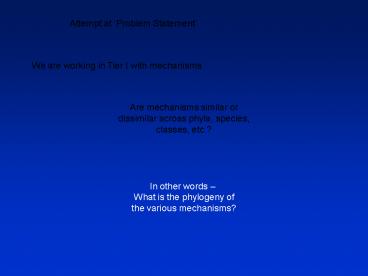We are working in Tier I with mechanisms PowerPoint PPT Presentation
1 / 19
Title: We are working in Tier I with mechanisms
1
Attempt at Problem Statement
We are working in Tier I with mechanisms
Are mechanisms similar or dissimilar across
phyla, species, classes, etc.?
In other words What is the phylogeny of the
various mechanisms?
2
In particular, what is the phylogeny of
- Nuclear receptors as they bind the the ligands
and activate particular genes and pathways - P450s as they synthesize and metabolize most
NR ligands
Regrettably, will emphasis more of what we dont
know, than what we know
3
Nuclear Receptors
Metazoan signaling pathways 5 Basic evolutionary
groups - based on DNA element structure (a
repeated sequence, some serial repeats,
some mirrored, and with n nucleotides
spacer) - based on gene structure
intron/extron point in DNA binding region of
protein - based on amino acid sequence homology
At this time, steroid family (E, A, G, P, M)
appears to be unique to vertebrates.
4
Metazoans
Bilateria
Deuterostomes
Protostomes
Lophotrochozoans
Ecdysozoans
Bryozoans Entoprocts Platyhelminthes Pogonophorans
Brachiopods Phoronids Nemerteans Annelids Echiura
ns Molluscs Sipunculans Gnathostomulids Rotifers
Gastrotrichs Nematodes Priapulids Kinorhynchs Onyc
hophorans Tardigrades Arthropods
Echinoderms Hemichordates Urochordates Cephaloch
ordates Vertebrates
5
Metazoans Nuclear Receptors
Bryozoans Entoprocts Platyhelminthes Pogonophorans
Brachiopods Phoronids Nemerteans Annelids Echiura
ns Molluscs Sipunculans Gnathostomulids Rotifers
Gastrotrichs Nematodes Priapulids Kinorhynchs Onyc
hophorans Tardigrades Arthropods
Echinoderms Hemichordates Urochordates Cephaloch
ordates Vertebrates
Vertebrates only Steroid Family (??)
ERab, AR, GR, MR, PRab
Note Greek letters indicate separate (multiple)
forms of the receptor exist - action, ligand
specificity, cell distribution may vary
TRab, ERRabg, VDR, RARabg, PPARabgd
Others also restricted to a few phyla
6
Implications
1. Is there a scientific basis or rationale
to extrapolate an EAT based screen to
other phyla?At this time, probably not!2.
This means we have no screens for the other
phyla.They are unprotected!
We have serious scientific gaps that need to be
filled!!!
7
Metazoans Nuclear Receptors
Bryozoans Entoprocts Platyhelminthes Pogonophorans
Brachiopods Phoronids Nemerteans Annelids Echiura
ns Molluscs Sipunculans Gnathostomulids Rotifers
Gastrotrichs Nematodes Priapulids Kinorhynchs Onyc
hophorans Tardigrades Arthropods
Echinoderms Hemichordates Urochordates Cephaloch
ordates Vertebrates
?? ?? ?? RXRabgd COUPabg
EcdR, KNIRPSabg
For invertebrates, outside Arthropods far less
known about NucRecs and their transcriptional
roles some are identified only as genes
8
Briefly, the P450s
Far more ancient Far more diverse But a
parallel way to analyze the problem
9
Lipid synthetic tree of ligands
DNA element Several core structures intron-exon b
reak in DNA region organization abcd abcd abcd
dcba nucleotide(s) spacing
10
Suggested analysis
What are the nuclear receptors that are
potential ED targets? What are the ligands
(mimic targets)? What are the synthetic steps
(P450scc, aromatase, 5-alpha reductase,
)? What then is the appropriate phyla for
which a screen can and cannot be used? (And
have a rationale basis to validate)
11
Nuclear Hormone Receptor Structure
DBD DNA Binding Domain Zinc finger
interaction Often repeated Several
configurations distinguish receptor
subclasses
LBD Ligand Binding Domain Large, 3 sided
cavity Envelopes ligand Largely hydrophobic
amino acids lining the cavity
12
Nuclear Hormone Receptor Structure
AF-1 Activation Factor 1 (site for activation by
several kinase or phosphorylation pathways)
AF-2 Activation Factor 2 (interaction with
other protein families one represses and one
activates) Essential for transcription
13
Nuclear Hormone Receptor Ligand Triggering Action
1
This free dimer appears susceptible
to proteolysis (ubiquitin)
Heat Shock Protein (HSP) chaperone complex
NH receptor Ligand Bound
DNA Response Element
L
CoRepressor
Receptor Dimer Formation
Binding DNA Element Sites
Dissociation
14
Transcribing Genes Into mRNA
1. Pol II Binds TATA Box
3. Pol II Initiates mRNA transcription
RNA polymerase II or pol II complex actually
transcribes, binds DNA at TATA box DNA site
2. Pol II Moves Down DNA
Pol II transcribing
TATA Box
Gene Start (AUG codon)
Base 0 for gene
Base X bases upstream for gene
15
Nuclear Hormone Receptor- Ligand Complex Action 2
RNA polymerase II or pol II complex actually
transcribes, starting at TATA box DNA site
- Response element for receptor is upstream of
TATA box - RNA pol II normally cannot bind to TATA box
alone, transcription blocked
DNA Response Element
TATA Box
Upstream of target gene by X bases
16
Nuclear Hormone Receptor- Ligand Complex Action 2
RNA polymerase II or pol II complex must bind
TATA box DNA site to transcribe target gene
Receptor-ligand (holo-receptor) does not
interact directly with the Pol II complex
DNA Response Element
TATA Box
Upstream of target gene by X bases
Upstream of the TATA box Y bases or X Y of
target gene
17
Nuclear Hormone Receptor- Ligand Complex Action 2
Recruitment of Coactivators is Necessary They are
an Obligate Bridge to Pol II complex
Receptor-ligand can bind DNA and NOT recruit
pol II Antagonist
18
Chemical Numbers vs Chemical Doses
Working Examples Perfume Raw Materials
Salvito et al. Env. Toxicol. Chem. 21(6)
1301-1308 Prediction of Environmental
Concentrations (PECs) for gt 2,100 chemicals
Prediction of PNEC PEC/PNEC ratio -
prioritization Simonich et al. Env. Sci. Tech.
36(13) 2839-2847. Measurement and Validation
of PECs
19
Thyroid Toxicological History
Adverse Effects and Mechanisms
Thyroid goiter/developmental toxicity Mechanism
s elucidated 1940-1990 - Iodide deficiency or
uptake blockade to thyroid - Inhibition of
thyroid peroxidase - Blockage of thyroid T3/T4
release - Increased T3/T4 metabolism- Inhibition
of 5-deiodinase- Life stage sensitivity vs
consequences Clear endpoints thyroid
histopathology, circulating T3/T4 and TSH

